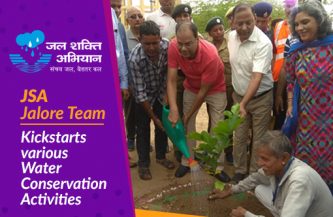Marshy dumping site turns into a beautiful park with a pond

The people of Haripur have converted a filthy water body into a beautiful park complete with a pond that people now frequent to either take a stroll or allow their children to play. The transformation of the marshy dumping site into the picturesque place that it is now is a matter of pride for the village.

According to Central Nodal Officer (CNO), Mr. Rajinder Kashyap, Joint Secretary, Ministry of Law and Justice, the pond at village Haripur, (Block Mehatpur, Tehsil Nakodar) has been developed by the village community using their own financial resources to the tune of Rs. two crore.


Earlier, the village pond was a nuisance to the people as water would overflow and run into the streets and houses of the village. The condition was worse during the monsoons when the pond would be swollen to such an extent that neither people nor vehicles could pass by. Aside from the stench it emitted, diseases such as diarrhea were attributed to the contaminated water.
To address the issue, the village community constituted a committee called The “Haripur Vikaas Committee” for the development of the village including the pond site. Their interventions included laying underground pipelines for drainage of household waste water and rain water separately; and then lining all the streets of the village with interlocking tiles. All the pipelines led to the village pond, effectively collecting every drop of water that came either from household activities or rain.


Dr. Maninder Singh, District Extension Specialist, Farm Advisory Service Scheme, Punjab Agricultural University (PAU) in Nurmahal, Jalandhar (Punjab) said that the work was done carefully, adhering to sound technology and use of quality material at a competitive price; completing the same in a record one year’s time.
The developed pond is a picturesque place and a good source for replenishing the underground water table and irrigating crops in nearby fields. The average household waste water coming to the pond was recorded as 70,000-1,00,000 litres per day which along with rain water can be used for irrigation or for infiltration into the soil.
Moreover, the pond was deepened so that the surface area could be reduced and the land recovered from old pond was used for recreation on which a beautiful park along with an open gymnasium, an indoor gymnasium and playing area for children were developed. This facility is being used to the maximum by the village community, especially women; which has invariable helped them keep fit and enhance social activities among residents.
Several dignitaries and eminent personalities have visited the site to study its uniqueness and the praiseworthy efforts of the villagers. Government officials from almost all the districts of Punjab have visited the same as they have been directed by the government to replicate the model in their areas.

Technical support for the entire process was provided by from PAU’s Farm Advisory Service Centre (FASC) in Jalandhar. It is a project of the Department of Science and Technology, PAU, developed on basis of ‘Seechewal Model’.
How Seechewal Model keeps villages clean and green: Under this model, water from the village sewerage system is collected into a pond. A filter-mesh is used to remove objects floating on the surface of water. The polluted water is processed through three separate wells. While in the first well silt from the sewerage is removed, in the second, fats, oil and ghee are taken away. The third well conveys the thus cleaned water into the main pond where it is cleaned through sun rays. On the banks of the pond on the opposite side of the three wells, a motor pump is installed to lift the treated water and channel it so it can irrigate the fields. A plantation is grown around the treatment plant.

[ The Blog was published on https://jalshakti.wordpress.com/ ]





